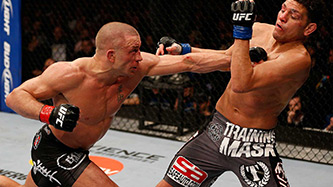You, of all people, will understand why I might go in to a film like Takedown: The DNA of GSP with a bit of skepticism. The UFC is fiercely protective of their macho image, so a documentary about one of their biggest stars is bound to be about as revealing as a Justin Bieber concert film. In order to show the biggest fights of George St. Pierre's career, and the intense training that preceded them, the UFC's full cooperation must have been a pre-requisite. Which means this film is less a documentary than it is branded content, designed to sell the sport, and no better than the The Ultimate Fighter reality series--or anything else on Spike TV.
So I should congratulate you in a job well done. Because I'm sold. On your film, anyway. Not so much mixed martial arts.
It's a brutal way to make a living, after all. St. Pierre himself puts it nicely during an archival interview when he says he's fighting for legitimacy as an athlete because, unlike hockey or football, "you can't say I'm gonna play MMA. It's not a game." And it's those stakes that helped me invest in St. Pierre as a protagonist (his being Canadian doesn't hurt, either). More interestingly, unlike most action heroes, he's not invincible (GSP's DNA is often leaking out all over his face). He's not even undefeated. In fact, his own trainer admits that St. Pierre's not the best at any particular fighting style. It's his work ethic and ability to actually mix the martial arts that makes him so dangerous. That, and his ability to channel OCD into a rigorous training routine.
A few fresh techniques used by co-directors Kristian Manchester and Peter Svatek also helped win me over. The constant cross-cutting to footage of a wolf stalking through the snow was a rather blunt metaphor, but the black and white re-enactments of St. Pierre's youth, staged through photography, felt special. Sure, it may romanticize his struggles with being bullied, but it felt balanced by a sobering press conference with his fiercest rival, Nick Diaz. This rivalry is what fuels the second half of the film, with scrappy inner-city Diaz being the perfect foil for St. Pierre's disciplined, gentlemanly persona.
The film's final confrontation ends up referencing those sequences of St. Pierre's youth. The fight is featured in black and white super-slow-motion shots with no commentary. It's also slightly out of sequence. This new way of looking at the fight will probably help fans of the sport see the tactics and strategy with fresh eyes, and kept me from feeling like I was simply sold tickets to a Sportscentre highlight reel.
Or maybe it was treated that way because you weren't able to acquire the rights. But don't tell me. I don't want it to tarnish the film's precious image.
Clearing out,
Christopher







